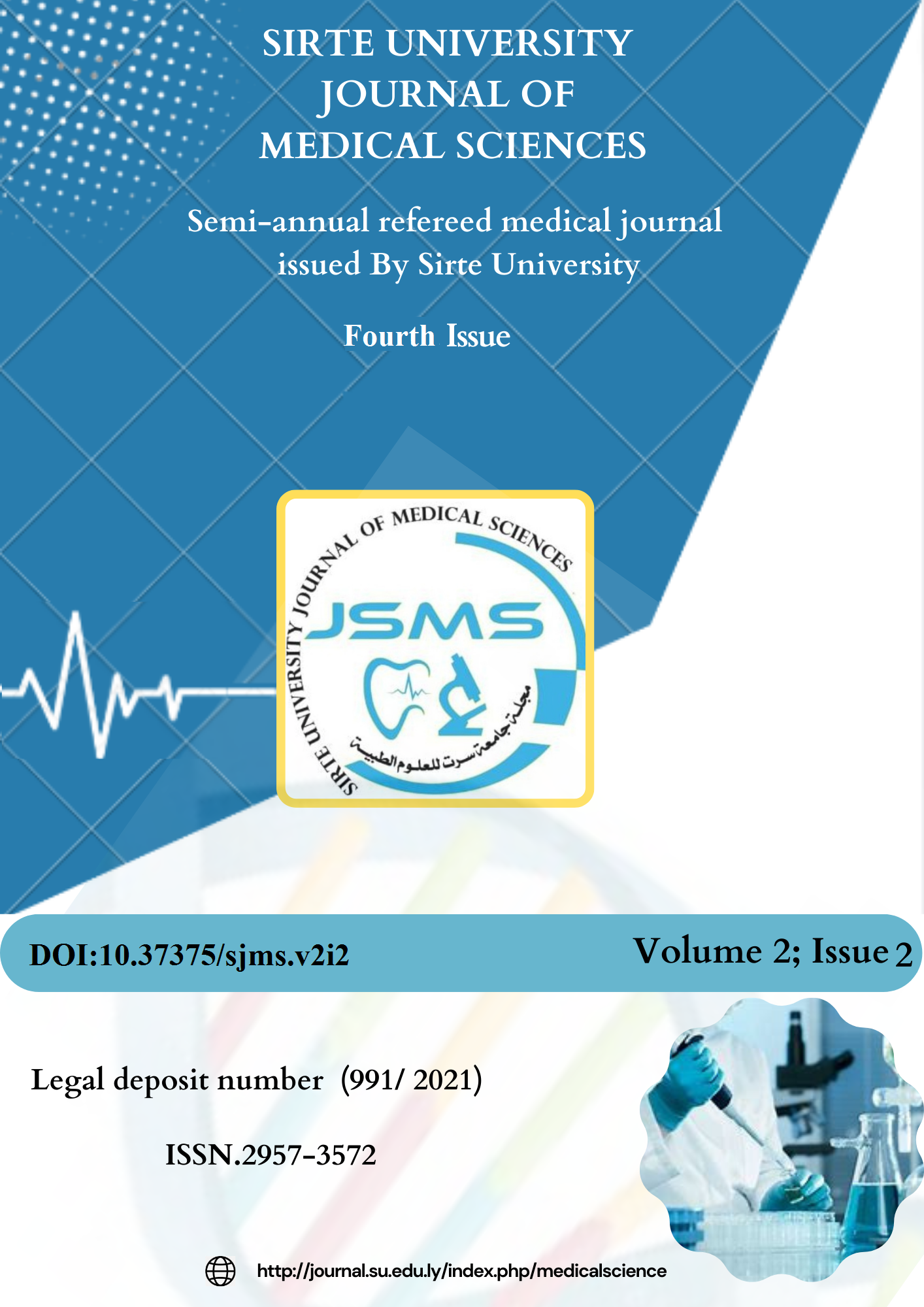Infection rate of Enterobius vermicularis ( Pinworm) among school children in Sebha, Libya.
DOI:
https://doi.org/10.37375/sjms.v2i2.2541Keywords:
Pinworm, scotch tape,, Sebha,, Libya.Abstract
Helminthic infections caused by Enterobius vermicularis have a cosmopolitan character and most often affect the paediatric pre-school and school age population. This helminth is the most frequent in Libya, but it is as yet unrecognized, probably due to parasitological laboratories not being consulted. The cellophane scotch tape method was used to investigate the presence of E. vermicularis eggs in 115 specimens. The overall infection of this parasite was 11.3%.Out of 115 school children (62 boys and 53 girls) nine (14.51%) boys, and four (7.54%) girls, were found infected with this parasite. There was a significant difference (X2=5.39, P=0.022) between both genders. Highest prevalence rate (13.84%), was found among 8 to10 years old age group. The adhesive scotch tape method appeared to be sensitive and appropriate choice to diagnose infection of E. vermicularis..
References
Ali, M.B., Ghenghesh, K.S., Aissa, R.B., Abohelfaia, A. and Dufani, M. (2005).Etiology of childhood diarrhea in Zlieten, Libya. Saudi. Med. J. 26: 1759-1765.
Al-Fellani, M. A., Abdulrahman , O. M., Khan, A. H. and Abousaif, A. A. (2005). Prevalence of intestinal parasites in Sebha, Libya. Garyounis Med. J. 22: 56-60.
Al- Kilani., MK, Dahesh, SM. and El Taweel HA. (2008): Intestinal parasitosisin Nalout popularity, western Libya. J. Egypt. Soc. Parasitol. 38: 255-64.
Ayeh-Kumi, P., Quarcoo, S, Kwakye-Nuako, G, Kretchy, J, Osafo-Kantanka. A, and Mortu S. (2009):. Prevalence of intestinal parasitic infections among food vendors in Accra, Ghana. J. Trop. Med.Parasitol, 2:1–8.
Ben Mousa, N. A. (2007). Intestinal parasites and the first case report on amoebiasis in urinary bladder in Tripoli, Libya. J. Egypt. Soc. Parasitol. 37:755-784.
Bolbol, A. S., Warsi, M. M., El-Nageh. and Mabrouk. M. (1981). The incidence of intestinal parasites in the Tripoli area of Libya. Sina. Med. Assoc. J. 1: 13-15.
Bugharara, S. I., Ali, M. Y., Khan, A. H. and Nadia, I. E. (1999). Incidence of Cryptosporidium in patients with diarrhea. Riv. Di. Parasit. 16: 169-172.
Burkhart, C.N. and Burkhart, C.G.(2005): Assessment of frequency, transmission, and genitourinary complications of enterobiasis (pinworms). Int. J. Dermatol. 44:837–40
Chan, MS. (1997): The global burden of intestinal nematode infections—fifty years on. Parasitol Today,13 :438–43.Cook GC. Enterobius vermicularis infection. Gut. 1994;35:1159–62.
Cook, G.C. (1994):Enterobius vermicularis infection. Gut. 35:1159–62
Dar, F. K., El-Kouly, S. I., Hoda A., El-Boulaqi., Munir, R. And El-Maghrebi, S. (1979). Intestinal parasites in Benghazi school children. Garyounis Med. J. 2: 3-7.
Dar, F.K. and Friend, J. E. (1979). Parasitosis in a closed community. A pilot study. Garyounis Med. J. 2: 95-9.
De Silva., N.R., Brooker S, Hotez P.J., Montresor A, Engels D, and Savioli L. (2003): Soil transmitted helminth infections: updating the global picture. Trends Parasitol.19 :547–51.
Duc PP, Nguyen-Viet H, Hattendorf J, Zinsstag J, Cam PD, and Odermatt P. (2011): Risk factors for Entamoeba histolytica infection in an agricultural community in Hanam province, Vietnam. Parasit. Vectors. 4 :102.
Emna, S.; Imène, T.; Jihène, B.; Nada, B.; Najet Z.; Karim, A. and Aida, B. (2015): Evolution of the prevalence of intestinal parasitosis in the region of Tunis from 1996 at 2012 Tunis Med. 93(11):687-91..
El-Buni, A.A and Khan, A.H.(1998). Intestinal Protozoan infections in Benghazi. Sebha Med. J.1: 106-108.
El-Buni, A. A., Khan, A. H., Griew, A. E. and Waliaden, Q. (1998). Prevalence of intestinal parasites among expatriates in Benghazi, Libya. Jamahiriya Med. Sci. Congress, Benghazi, 1-4 Nov, Benghazi, Libya.
Fallah M., Parsaei M., Soleymani E., Jamshizad A., Azimi A. Investigation of the prevalence of Enterobius vermicularisInfection and risk factors among kindergartens in Hamadan, west of Iran, in 2019. Avicenna J. Clin. Med. 2022;28(4):253–259.
Gelani, S.S., Abdulhafeez, K. Abdul Gader, Ajaili, Awatif, M.A., Mohammed Al-Shebani and Yosef, K. (2009). A study of prevalence of human intestinal parasites in Wadi-Al-Shati region. Sebha. Med. J. 2: 3-7.
Girma A, and Aemiro A.(2022): Prevalence and Associated Risk Factors of Intestinal Parasites and Enteric Bacterial Infections among Selected Region Food Handlers of Ethiopia during 2014-2022: A Systematic Review and Meta-Analysis.Sci.Worl. J. 2022 Oct 12;2022:7786036.
]Kang S, Jeon HK, Eom KS, Park JK. Egg positive rate of Enterobius vermicularis among preschool children in
Cheongju, Chungcheongbuk-do, Korea. Korean J
Parasitol. 2006;44:247–249. doi: 10.3347/kjp.2006.44.3.247.
Kara, W F, El-Heggiagi MB, and Shan A O. (2006): Cryptosporidiasis among children in Triploi. J Egypt. Soc.Parasitol.36 :107112.
Khalifa S.G. , Khaled G, Elloulu T. B. D, Khaled S, and Ezzadin F. (2016): Prevalence of Entamoeba histolytica, Giardia lamblia, and Cryptosporidium spp. in Libya: 2000-2015.Libyan J. Med. 11, tp://dx.doi.org/10.3402/ljm.v11. 32088.
Kim, D.H; Cho, M.K; Park, M.K; Kang, S.A; Kim, B.Y; Park, S.K. and Yu, H.S. (2013): Environmental factors related to enterobiasis in a southeast region of Korea. Korean J .Parasitol. 51:139–42.
Kuang-Yao C ; Chuan-Min Y; Kao-Pin H. and Lian-Chen W. (2018): Enterobius vermicularis infection and its risk factors among pre-school children in Taipei, Taiwan. J. Microbiol. Immunol. Infect.51(4):559-564. doi: 10.1016/j.jmii.2016.12.013.
Kucik, C.J, Martin, G.L. and Sortor B.V. (2004): Common intestinal parasites. Am. Fam.Physician. 69:1161 1168.
Kubiak, K; Dzika, E. and Paukszto, L. (2017): Enterobiasis epidemiology and molecular characterization of Enterobius vermicularis in healthy children in NorthEastern Poland. Helminthologia.54:284–291.
Le Bailly , M and Araújo, A .(2016):Past Intestinal Parasites. Microbiol. Spectr. Aug;4(4).doi: 10.1128/microbiolspec.PoH-0013-2015.
Li HM, Zhou CH, Li ZS, et al. (2015): Risk factors for Enterobius vermicularis infection in children in Gaozhou, Guangdong, China. Infect. Dis. Poverty. 4:
Myoung, R. L; Hee-Eun S. S. B; Young-Ju L; Jung-Won J; Chun S. P; Hee-Il L. (2023): Positive rates for Enterobius vermicularis eggs among preschool children in Yeosu-si, Jeollanam-do, Korea (2017-2021). Parasit. Hosts.Dis.61(1):84 88. Do10.3347/PHD.22121.
Ng Y.W, Ng S.B and Low J.J. (2011): Enterobiusvermicularis infestation of the endometrium - a cause of menstrual irregularity and review of literature. Ann. Acad. Med. Singapore .2011; 40:514-5.
Norhayati M, Fatmah M, Yusof S, and Edariah A. (2003): Intestinal parasitic infections in man: a review. Med J Malays . 58:296–305.
Pampiglione, S. andRivasi, F.(2009):Enterobiasis in ectopic locations mimicking tumor-like lesions. Int. J. Microbiol.:642481. https://doi. org/10.1155/2009/642481.
Rasha, K; Souad, B; Sameh, A; Majd, B; Lujain, A; Walid, B. (2015): Prevalence of and risk factors for Enterobius vermicularis infestation in preschool children, West Bank, Palestine, 2015. East Mediterr. Health. J. Dec 1;27(11):1052-1060. doi: 10.26719/emhj.21.022.
Sadaga, G.A. and Kassem, H.H. (2007). Prevalence of intestinal parasites among primary school children in Derna District, Libya. J. Egypt. Soc. Parasitol. 37: 205-214.
Sah, S.P. and Bhadani, P.P. (2006): Enterobius vermicularis causing symptoms of appendicitis in Nepal. Trop. Doct., 36(3): 160 – 162.DOI: 10.1258/004947506777978361
Saleh, M. M. (2007): Prevalence of human intestinal parasites in Sebha city. M. Sc. Thesis, Sebha University, Sebha, Libya.
Salem, R. A. A., Abdullah, M. E. and Abdulgader, A. E. (2007): Intestinal protozoa in Libyan patients in Sirte. Jamahiriya Med. J. 6: 59-61.
Serpytis, M.andSeinin, D. (2012): Fatal case of ectopic enterobiasis: Enterobius vermicularis in the kidneys. Scand. J. Urol. Nephrol. 46:70-72.
Shinji, F; Eiji, M. and Atsuo, H. (2010): The prevalence of Enterobius vermicularis among Japanese expatriates living in developing countries. Kansenshogaku Zasshi.84(1):19-23. doi:10.11150/kansenshogakuzasshi.84.19.
Seyed, A.N.A.; Ali,N. A,; Mohammad T. R.; Seif, A. M.; Mahmood, M.; Omid, R.; Ali, F. K.; Reza, R. and Seyed, A. S. (2016): Prevalence of Enterobius vermicularis infection among preschool children, Babol, North of Iran. J. Parasit. Dis. 40(4):1558-1562. doi: 10.1007/s12639-015-0727-4.
Walid, E.; Haitham E.; Anan, A.; Hammed, E. S.; Mohamed B.; Samy, F. M.; Mustafa S. A. and Wael, F. E.T. (2021): Prevalence of intestinal parasitic infections and their associated risk factors among preschool and school children in Egypt. PLoS One. 16(9):e0258037. doi:10.1371/journal.pone.0258037. eCollection 2021.
World Health Organisation. (2003): Diarrhoea remains a principal cause of illness and death. Bulletin of the World Health Organization, 81:197–204.











